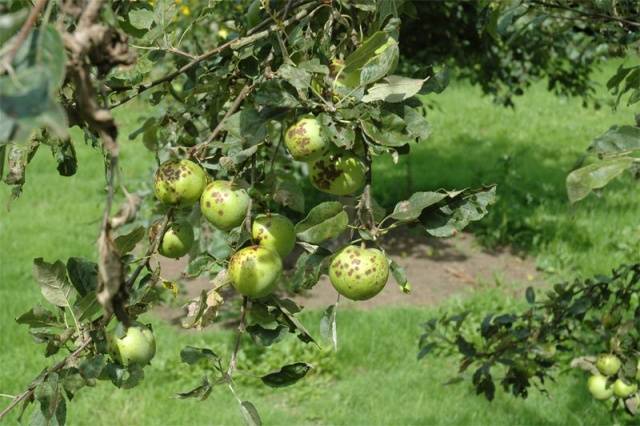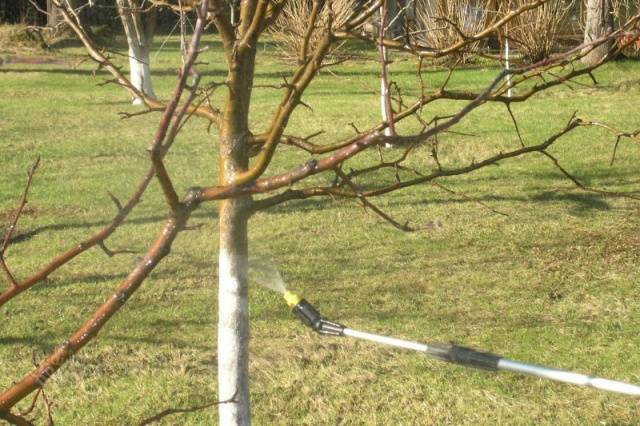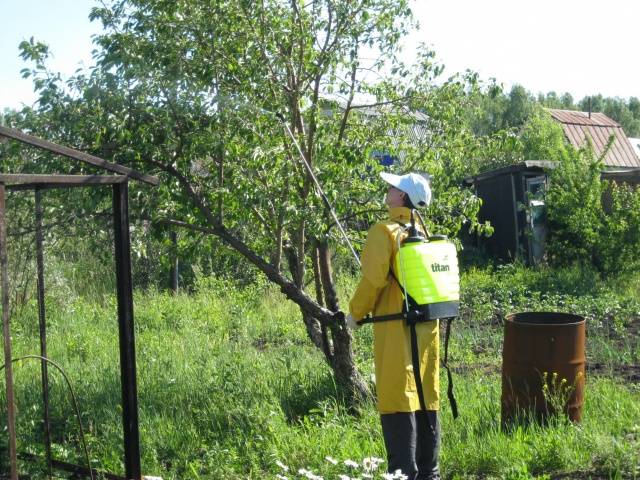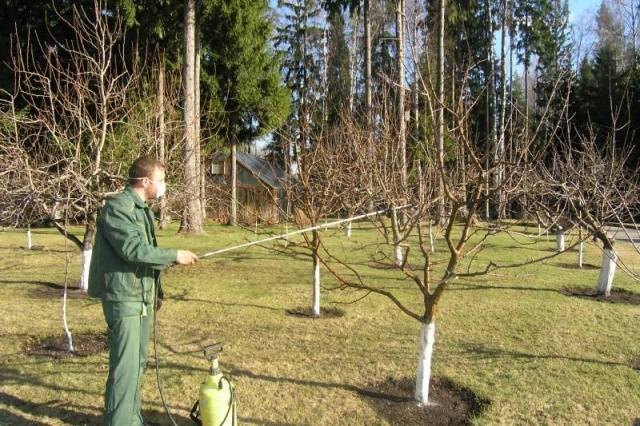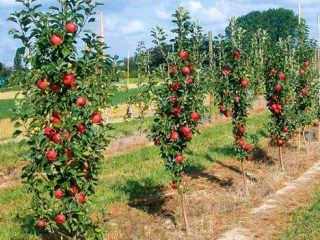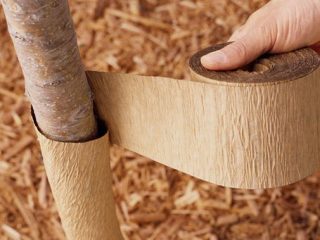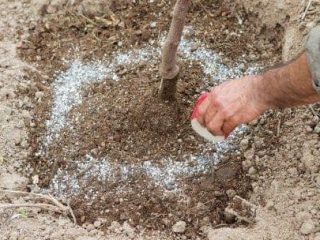Content
Scab on an apple tree is a fungal disease that is often found on many fruit trees. Millions of insects: ants, beetles, butterflies carry microscopic spores of the fungus on their bodies, leaving them on all parts of the tree, on leaves, fruits, bark. For the time being, the disputes are in relative peace until they receive favorable conditions for their development. Such conditions occur after heavy rains. Moisture, falling on fungal spores, gives them food for rapid and harmful (for trees) spread. To fight with scabby necessary in spring, summer, autumn, otherwise the leaves of the apple tree will dry out, the fruits will lose their presentation, and the branches and trunks will be constantly corroded by scab (see photo).
Scab on an apple tree
Main features
At the beginning of spring, the main carriers of scab spores - insects - wake up. Winds and rains also carry fungal spores, which quickly spread throughout the garden plants. Noticeable changes occur on apple and pear trees:
- The first stage of the manifestation of scab on an apple tree: a coating appears on the leaves of the tree at the sites of infection, its color is olive, and the texture is velvety.
- The second stage of scab development: spots on scab-affected leaves darken and become light brown.
- The third stage of the tree disease: young shoots of the apple tree turn black, dry out and droop, leaves fall off prematurely, cracks appear on the branches of adult plants, many dark brown spots form on the fruits, apples crack and fall.
Scab on an apple tree reduces productivity, fruits lose their marketable appearance, apple trees weaken, their viability decreases, they die in winter, not having the strength to withstand frost. To help apple trees overcome the disease and withstand the fight against it, gardeners annually treat fruit trees in different ways. In spring, summer, autumn, sometimes in winter (weather permitting) they go out to fight ruthlessly against scab. We will tell you about some ways and methods of this fight, with which you can protect the trees in your garden.
Please watch the videos posted in the relevant sections of our article. They will help you put all these activities into practice.
Fighting methods
There are many ways to protect fruit trees from scab damage; it is necessary to use comprehensive measures: prevention, chemicals, folk remedies. You need to start with preventive measures, even if your apple trees are completely healthy:
- timely cleaning of the garden area from fallen leaves and fruits;
- removal of scab-infected branches, leaves and apples;
- disposal of plant residues (combustion);
- regular loosening and digging of the soil around the trunks of the apple tree;
- it is necessary to eliminate deficiencies in fertilizing, apply fertilizers in the right quantity and at a certain time;
- constantly monitor the flow of moisture: during heavy rains, do drainage, and during dry periods, watering is needed - 2 times a week, 20 liters of water per tree;
- 1-2 times per season it is necessary to spray the apple trees with a fungicide solution (Bordeaux mixture, sulfur color, etc.).
Let's take a closer look at what measures need to be taken in spring, summer and autumn to prevent or eliminate scab symptoms.
Spring prevention
In the spring, when the trees bloom their first buds, young shoots and leaves are very vulnerable to many fungal diseases. Regular spring work related to the prevention of apple scab disease:
Apple tree treatment in spring
- Apply organic fertilizers along a tree trunk circle with a diameter of 0.6 - 1.0 meters: manure, compost, peat and ash rotted over the winter, observing the application rates for fruit trees: manure - 2-3 buckets, compost - 2 buckets, peat - 1 bucket , ash - 0.5 buckets;
- dig up the soil, removing last year's leaves and fallen branches;
- water the apple tree with water (10-15 liters);
- treat wet soil with additional solutions of urea (carbamide), potassium chloride or ammonium nitrate (see video);
- Apply lime whitewash to the trunks to a height of up to 1 m;
- Spray all branches and trunk with a solution of Bordeaux mixture.
Try to complete all these activities before the first buds bloom on the apple tree.
Fight in the summer
In the summer, in June-July, it is time for the second stage of the fight against scab. Autumn prevention and all the measures taken against scab may not be as effective as you expected.May rains wash away from the leaves the preparations with which the trees were treated at the beginning of spring. Scab spores that were not killed during the initial spraying quickly invade and devour new areas on the leaves and twigs of apple trees. Gardeners are forced to carry out secondary summer cultivation of the garden, so as not to give the harvest to a voracious fungus.
Apple tree treatment in summer
This work must be done before the apple trees begin to set fruit, that is, immediately after flowering.
Main events during this period:
- make secondary fertilizing of the apple tree with complex fertilizers; you don’t have to use organic matter; use chemicals, solutions of which can be combined with spraying against scab;
- remove all fallen leaves and fruits of the apple tree infected with scab, dispose of it or burn it;
- dig up the soil around the tree trunk, treat with potassium chloride, urea or ammonium nitrate, adding ferrous sulfate to the solution;
- Spray the apple tree with scab agents, those indicated in the table or other suitable ones;
- After 2 weeks, repeat spraying treatment.
This concludes the summer fight against scab. Chemicals should not be used a month in advance and during fruiting.
In the video you can see how to spray tall trees. Try to get the solution onto the back of the leaves, all the branches and the trunk. You may need a lot of solution; in summer, the foliage on the apple trees has already blossomed, the surface of the treated areas has increased significantly, so calculate in advance how much of the product you need to buy.
Treatment in autumn
In the spring, we carried out scab prevention on the apple tree, and in the summer we sprayed the apple trees twice in order to stop the development of the fungus and protect the trees from further scab damage. In the fall, it is necessary to consolidate the result so that the apple trees become stronger, freed from the harmful effects of the disease and can overwinter well. The main activities are the same as in spring and summer: fertilizing, spraying with fungicides (see video), removing infected leaves and branches.
In addition, it is necessary to eliminate other causes of scab development on the apple tree:
- Tree pruning and thinning. Scab develops quickly if the apple tree receives little sunlight, that is, the crown is very thick. It is necessary to trim those branches that grow inside the crown, directed towards the trunk of the apple tree. It is recommended to trim large and thick branches gradually (1-2 pieces per season) so as not to injure the plant too much. Young shoots not infected with scab are cut by 1/3, diseased shoots are removed completely.
- Treatment against wintering pests. Some types of insects remain overwintering in the soil; those that choose tree trunk areas as their wintering grounds are especially dangerous. In the spring, they become the first to infect a tree with scab. Spraying with pesticides will help destroy such pests. The soil around the apple tree (the diameter of the circle is at least 2 m) must also be cleared of eggs and pests hibernating in the ground. To do this, the tree trunk circle is spilled with the same chemical solutions.
By following all the recommended measures, from spring to the onset of wintering, you will protect your apple trees from this terrible fungus.To finally get rid of scab, it is necessary to carry out the entire complex of scab control over 2-3 seasons.
Treatment in autumn
Folk remedies
For gardeners who do not accept the use of chemicals in the garden, we recommend some traditional methods of combating scab.
- Saline solution. For a 10-liter bucket of water, 1 kg of salt is used. Spraying is carried out in early spring, when the apple trees are still dormant, that is, before the buds swell.
- Horsetail tincture. 1 kg of fresh horsetail herb is poured into 5 liters of boiling water, left for 3 days, then 1 liter of this infusion is diluted with 10 liters of water. Spray apple trees when the first leaves appear.
- Mustard solution. Dissolve 100 g of dry mustard in a bucket of hot water, stir thoroughly until the powder particles are completely dissolved. This solution can be used to spray apple trees against scab at any time, regardless of the growing season of the tree. For the entire season, 4 sprayings are done.
- Potassium permanganate solution. The solution should be highly concentrated and dark purple in color. It is used for the treatment and prevention of scab on apple, pear and other fruit trees. Sick and healthy plants are treated 3 times with an interval of 20 days.
- Whey bacteria. Prepare fresh serum, filter through gauze so as not to clog the sprayer tube, pour into a spray container and treat the diseased tree and all its parts: leaves, fruits, branches. Experienced gardeners guarantee that scab on an apple tree will be destroyed the first time.
Friendship with a neighbor
Our gardeners' summer cottages are often closely located to each other; due to the small areas, they are separated only by low fences.All your scab control may be ineffective if your neighbor's infested apple trees are not treated properly. Soon, fungal spores will move from neighboring trees to your already cured apple trees.
For such a fight, you need, it is simply necessary, to make friends with your neighbors, to pool your strength and resources in order to eradicate this infectious disease from your gardens. Only if this condition is met will you completely get rid of the scab, and the productivity of the apple trees will not suffer.
Conclusion
Scab on an apple tree is a dangerous disease, but gardeners’ constant care for their green pets helps in the fight against the fungus. They will not allow the death of the plant, showing their love by tirelessly helping a sick sprout, even the smallest or already matured one.
